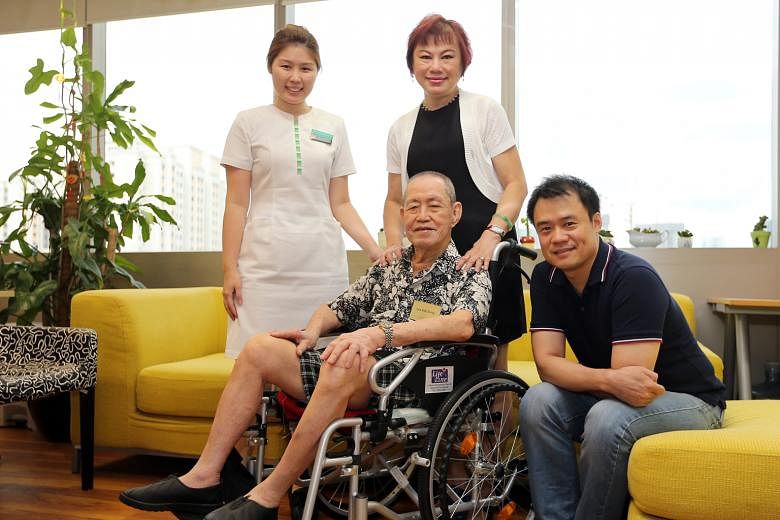Retiree Lee Kok Siang, 96, spent more than six months at various hospitals after being admitted for injuries, after a fall in July last year.
"He had six stitches for a cut above his eyebrow and was finally discharged in September, but just two days later, he had a second fall and had to be admitted back into the hospital," said his daughter-in-law Florence Lee, 59.
When he was warded in Singapore General Hospital (SGH) for the second time, his case was flagged to a team of "patient navigators".
These are nurses who are specially trained to plan post-discharge care for patients with complex health and social issues to help them transition home smoothly.
The scheme, introduced in 2014 in SingHealth group, also aims to prevent repeat incidents that will land the patient back in hospital.
There are nearly 100 such navigators in hospitals and speciality centres, such as KK Women's and Children's Hospital and the National Heart Centre Singapore.
At SGH, the scheme has been successful in cutting the number of visits to the accident and emergency (A&E) department.
From April 2015 to June last year, SGH identified nearly 5,000 patients who needed more post-discharge help due to chronic conditions or inadequate support at home, by tracking A&E attendances. Patients who repeatedly visited the department were assigned patient navigators.
For the next six months, the total A&E attendances for the same group of patients were reduced by 52 per cent, compared to the preceding six months.
Senior staff nurse Benecia Tan, 28, who is Mr Lee's patient navigator, said: "Many elderly patients like Mr Lee have high risk of falls and may be readmitted as a result. Other factors we look out for are patients who live alone or are on multiple medications for chronic conditions."
The navigators also make care arrangements for patients, based on their preferences and needs.
For example, after Mr Lee was transferred to Bright Vision Hospital for rehabilitation, Miss Tan recommended that he move to a nursing home to prevent further falls.
However, Mr Lee wanted to stay at home, so Miss Tan arranged for him to attend an eldercare programme by Tsao Foundation.
Mr Lee, who now attends Hua Mei Centre for Successful Ageing every weekday, said in Cantonese: "I'm very happy and comfortable here, it is like my second home."
Ms Wong Yock Leng, 47, a senior care manager at the Hua Mei centre, said working with patient navigators helped to facilitate a clear transition of care from hospitals to the community.
"Previously, service providers such as ourselves were unsure who the main contact point is - who can give us accurate and clear information about the patient who has been referred out to the community for continual support," she said.
Patient navigators go through four months of training, and each takes care of 40 or more patients. The follow-up period ranges from three months to a year, depending on the patient's condition.
Once the patient's condition is stable, patient navigators will leave their care to community partners like the Tsao Foundation.
Besides the eldercare programme, Miss Tan also arranged for meals to be delivered to Mr Lee's home on weekends.
Additionally, she coordinated a home visit by therapists and doctors who suggested safety modifications to Mr Lee's home to reduce his risk of falls. This included rearranging furniture so he does not need to get up from the bed to watch television.
They also taught him how to use two types of walkers - with and without wheels - to facilitate movement at home.
Both Miss Tan and Mrs Lee observed that Mr Lee appears much happier these days, and even looks like he put on some weight.
Said Mrs Lee: "He used to nag me every time I visited him in the hospital, asking when he could go home. He ate very poorly then. As family, we're happy as long as he's happy."

